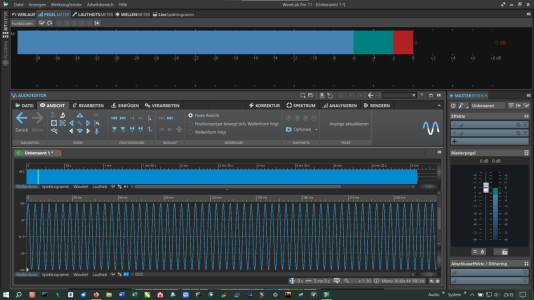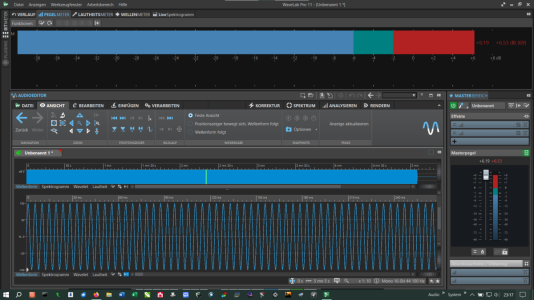hgo58
Major Contributor
No. Sorry. I have a hard time with understanding what you write.Do you understand the profound impact of the DRC here...?
everything is distorted...
;-)
I know what DRC is but cannot see the relevance for measuring the dBFS.
No. Sorry. I have a hard time with understanding what you write.Do you understand the profound impact of the DRC here...?
everything is distorted...
;-)
That came from the Wikipedia articleYes. +3 dB. Not +3 dBFS.
Look for the discussions from a few months ago about this DRC... which were swept under the rug but which render your rigorous considerations regarding the VU meter obsolete... and which actually had a heavy impact in many sensitive subjects here .. never addressed... a very clumsy Wiim workaround...No. Sorry. I have a hard time with understanding what you write.
I know what DRC is but cannot see the relevance for measuring the dBFS.
You still want to know the peak level regardless of DRC. What profound impact are you talking about?Do you understand the profound impact of the DRC "anti-saturation digital" here...?
everything is distorted...
;-)
Even though I understand your justified request for many months...
;-)
Are you talking about the limiting that WiiM use to prevent clipping? Yes I can see that would complicate things.Look for the discussions from a few months ago about this DRC... which were swept under the rug but which render your rigorous considerations regarding the VU meter obsolete... and which actually had a heavy impact in many sensitive subjects here .. never addressed... a very clumsy Wiim workaround...
;-)Are you talking about the limiting that WiiM use to prevent clipping? Yes I can see that would complicate things.
Before, of course.measure before or after drc? ;-)
And is explained hereThat came from the Wikipedia article
I'll let you investigate... ;-)Before, of course.
Do the compression even happen on the digital outputs? Or only before the DAC?
So you think WiiM is using DRC in other cases than to avoid clipping in the DAC after applying gain in the EQ settings?I'll let you investigate... ;-)
But realizing the impact on the rest of the circumstances used on different Wiim systems (not only ultra -vumetre) remains quite essential, it seems to me...
;-)
It is documented hereNo. Sorry. I have a hard time with understanding what you write.
I know what DRC is but cannot see the relevance for measuring the dBFS.

If the WiiM algoritme always reduce any applied gain then we don't need a clipping indicator but it would still be good to have an real indication of how close the signal level is to 0 dBFS.It is documented here
A happy Wiim Pro owner here. Having the Wiim volume set to fixed I have been somewhat reluctant to use the EQ though.
In this and other threads on this forum regarding EQ, the consensus seems to be that that clipping can/will occur in a situation like mine: having fixed volume (or at 100 %) and using positive gain in the EQ.
Wiim though, states the following:
https://faq.wiimhome.com/en/support...ow-to-use-parametric-eq-a-comprehensive-guide
Is it unnecessary to decrease the volume or having digital headroom when applying positive EQ...
Indeed, it's more complex... but my assessment is slightly more negative...because it systematically hides many negative situations where positive gains in corrections, etc., will be unreadable due to saturation, where a simple "overload" in Wiim Home (like streaming white noise at 0dB would allow you to adjust the gains accordingly...)I just did a few VU-meter tests myself:
My conclusion based on above results is that the current implementation of VU meter doesn't match signal peak nor signal RMS levels.
- VU meter "Original Signal" setting
- With -14dBFS RMS / -11dBFS peak 1kHz sine the VU meter shows about -11dB
- With -14dBFS RMS / -8.5dBFS peak pink noise the VU meter shows about -6dB
- With either input signal VU meter level doesn't change when I enable EQ or RoomFit with +6dB boost at 1kHz, nor when I added +7dB of pre-gain boost to the input, or changed output level.
- VU meter "Output Amplitude" setting
- Pink noise and 1kHz tone with the same -14dBFS RMS level result in different VU meter readings (i.e. like above).
- VU meter level is affected by input pre-gain, output level, EQ and RoomFit.
Regarding DRC, IMHO @canard is implying that the story is more complicated than it really is.
According to my tests, WiiM only apply DRC/limiting when the output of the device would be pushed over 0dBFS in digital domain, to avoid hard clipping.
DRC seems to be triggered only when output volume is at (or close to) 100%, combined with some kind of digital boost (either pre-gain, EQ or RoomFit) and when playing back content with peaks close to 0dBFS. I.e. even with boosts in the flow DRC won't be triggered if volume isn't high enough to end up above 0dBFS at DA conversion (or digital output).
For sure DRC/limiting is much more gentle to the ear compared to digital clipping, so I personally find this limiter to be a smart safeguard, useful for casual users who might not know how to achieve optimal gain staging.
I'm with you that optimizing the signal level in WiiM devices is not intuitive with the current implementation.Indeed, it's more complex... but my assessment is slightly more negative...because it systematically hides many negative situations where positive gains in corrections, etc., will be unreadable due to saturation, where a simple "overload" in Wiim Home (like streaming white noise at 0dB would allow you to adjust the gains accordingly...)
It's a very relative camouflage...because in action, without digital clipping, it's much more than unpleasant...it creates significant distortion
. ;-)
it makes many regrettable situations illegible
So WiiM is trying to show a dBFS peak value on a dB meter. Don't make sense.I just did a few VU-meter tests myself:
- VU meter "Original Signal" setting
- With -14dBFS RMS / -11dBFS peak 1kHz sine the VU meter shows about -11dB
On the input there is no gain applied. That is fine. Can be used to see the dynamic range of the original signal if it really does show the absolute dBFS peak value.
- With -14dBFS RMS / -8.5dBFS peak pink noise the VU meter shows about -6dB
- With either input signal VU meter level doesn't change when I enable EQ or RoomFit with +6dB boost at 1kHz, nor when I added +7dB of pre-gain boost to the input, or changed output level.
This should show the resulting peak dBFS value after applying all types of gain and volume control. This can then be used to check how close the signal is to digital clipping.
- VU meter "Output Amplitude" setting
- Pink noise and 1kHz tone with the same -14dBFS RMS level result in different VU meter readings (i.e. like above).
- VU meter level is affected by input pre-gain, output level, EQ and RoomFit.
I don't see how you can use RMS for a digital playback. Maybe I am missing something here?My conclusion based on above results is that the current implementation of VU meter doesn't match signal peak nor signal RMS levels.
It would however be good to know when this happens, as it will probably change the sound profile. If you use the WiiM at fixed (100%) volume this could easily impact the signal forwarded to an external DAC/Amp with own volume control.For sure DRC/limiting is much more gentle to the ear compared to digital clipping, so I personally find this limiter to be a smart safeguard, useful for casual users who might not know how to achieve optimal gain staging.
from the moment when the Wiim devices are likely to modify the signal, correction etc (without automatic gain adaptation)...I don't really agree with youI'm with you that optimizing the signal level in WiiM devices is not intuitive with the current implementation.
I just don't think that is a very big deal in most cases.
You are correct that for transport e.g. by optical SP/DIF or SMTPE the number range is limited to 0dBFS. And anything above 0dBFS of the DAC will cause distortion. Fully agreed.What do you mean? The max dBFS value is defined to be 0. There are no positive dBFS values.


The mapping of dBFS, defined on the digital side by the DAC, to analog voltage in whatever analog dB definition is more or less arbitrary by electronic analog gain. 0 dB what analog? In #9 -18dBFS would be 0dBVU or +4dBu, which is actually 1.228 Volts RMS.0 dB is mapped to -18 dBFS